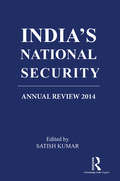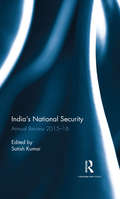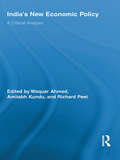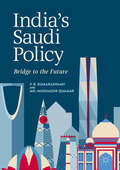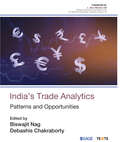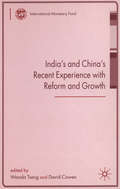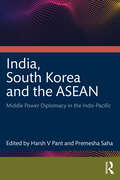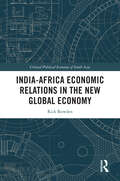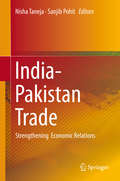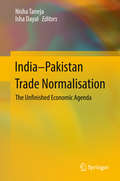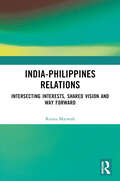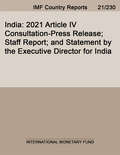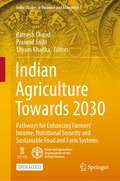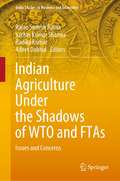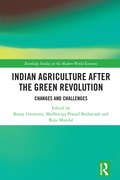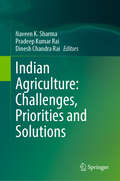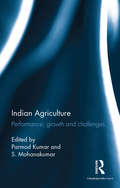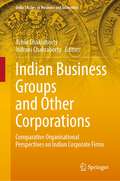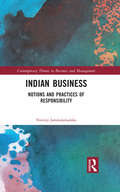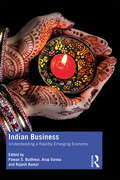- Table View
- List View
India's National Security: Annual Review 2014
by Satish KumarThis fourteenth volume of India’s National Security Annual Review intensively analyses India’s national security with respect to the changing internal and external dynamics. In the global environment, the situation is characterised by rising tensions between United States and Russia, intensified rivalry between United States (US) and China, and increasing cooperation between China and Russia. For India which seeks peaceful growth to emerge as a major power, this poses severe diplomatic challenges. This volume discusses the complexity of these challenges and the deftness with which India gets the best out of its strategic partnerships with the US and Russia while warding off the transgressions of a mighty adversary like China. It also studies the impact of internal convulsions and external intrusions on India’s security from South Asian nations such as Afghanistan, Bangladesh, Nepal and Sri Lanka. Examining the field of internal security, the essays carry rare insights into the causes of expansion of Naxalite violence in tribal areas and the dynamics of conflict resolution in the Northeast, as well as India’s deep concern as a growing power with its economic slowdown in the recent past, and energy and cyber security. Bringing together contributions from eminent scholars and diplomats, the volume will be indispensable for policymakers, government think tanks, defence and strategic studies experts, as well as students and researchers of international relations, foreign policy and political science.
India's National Security: Annual Review 2015–16
by Satish KumarThe last two years have witnessed deterioration in the global security situation characterised by increasing tensions among major powers. The threat perceptions of the US, China and Russia vis-à-vis each other have sharpened. There is stiff competition among them to dominate the strategic space in different parts of the world. This has led them to formulate national security strategies which are more assertive, aggressive and competitive. There is lack of consensus in resolution of conflicts in Afghanistan and Syria. There is no concerted effort in meeting the challenge of the Islamic State. It is in this fractured security environment that India has been making special efforts to project itself as a leading power commensurate with its economic and military potential. This fifteenth volume of India’s National Security Annual Review undertakes an incisive analysis of India’s endeavours to maximise its gains with respect to its strategic partners. The volume also focuses on the new dynamism that India has injected in its relations with countries in the Middle East and the Asia Pacific. India’s threat perceptions in its extended security zone, critical aspects of its strategic preparedness and complex issues regarding its internal security have been thoroughly examined. With contributions from experts from the fields of diplomacy, academia and civil and military services, the book will be one of the most dependable sources of analyses for scholars of international relations, foreign policy, defence and strategic studies, and political science, and practitioners alike.
India's New Economic Policy: A Critical Analysis (Routledge Studies in Development and Society)
by Waquar AhmedConventional interpretations of the New Economic Policy introduced in India in 1991 see this program of economic liberalization as transforming the Indian economy and leading to a substantial increase in the rate of India’s economic growth. But in a country like India, growth is not enough. Who benefits from the new growth regime, and can it significantly improve the conditions of livelihood for India’s 800 million people with incomes below $2.00 a day? This edited volume looks at international policy regimes and their national adoption under strategic conditions of economic crisis and coercion, and within longer-term structural changes in the power calculus of global capitalism. The contributors examine long-term growth tendencies, poverty and employment rates at the national level, regional level and local levels in India; the main growth centers; the areas and people left out; the advantages and deficiencies of the existing policy regime, and alternative economic policies for India. Bringing together the leading figures in the discussion on India’s economic policy, this volume is the authoritative critical study of India’s New Economic Policy.
India's Saudi Policy: Bridge to the Future
by P. R. Kumaraswamy Md. Muddassir QuamarThe book traces India’s Saudi Policy and locates the current state of bilateral relations and the challenges it faces. It argues that during the Cold War the relations were largely shaped by the Pakistan factor which in turn inhibited both sides from exploring the importance and value of one another. As a result, the relations were largely transactional and marginal. The end of the Cold War coincided with two interesting developments, namely, significant growth in India’s economic power and influence and the de-hyphenation of Pakistan from its Middle East policy. This resulted in greater political engagements between India and Saudi Arabia and was strengthened by the growing energy trade ties. For long expatiate population and haj have been the backbone of the relations, and they have been new instruments as India looks to enhance its engagements with the Kingdom through investments opportunities, political contacts, shared security concerns and strategic cooperation. India’s Saudi policy, however, face many challenges most importantly the regional instability, the Iran factor, low oil price and the international dynamics. The book will be the first comprehensive work on the India-Saudi relations. Though targeting a wider audience, it will be academically grounded and based on primary sources collected from India and Saudi Arabia.
India's Store Wars
by Geoff HiscockAs India's middle class grows and disposable incomes rise, "modern" retail is becoming the next hot sector of the Indian economy. Hundreds of millions of new consumers will join this retail revolution, venturing into supermarkets, department stores and air-conditioned shopping malls for the first time. But instead of just window shopping, many of them will be serious buyers with money to spend. To cater for their needs, established players in the modern retail sector such as Biyani, Raheja and Goenka are being joined by the big names of Indian business - Reliance, Birla, Bharti, Tata etc - who plan to spend billions over the next few years rolling out supermarkets, big-box outlets and specialty stores. At the same time, property developers are getting on with the "malling" of India, and looking for high profile anchor tenants to lure customers.On the sidelines of this Indian retail revolution are big overseas players such as Wal-Mart, which already has a tie-up with Bharti to provide much-needed "back office" support. But what Wal-Mart really wants is the right to set up its own stores in India. The same goes for Tesco, Carrefour, Metro and other international players.While the macro outlook appears bright, the problems are astronomical for India retail industry. There is no reliable cold chain, transport logistics are appalling, there is a huge lack of managerial talent, there is no consistency for quality and quantity of supply, there is political opposition from groups such as market middlemen, the mom and pop "kirana" corner stores have to be catered for, as do the farmers who grow the produce that is integral to a successful retail revolution. How well will these disparate players cope with the various pressures of a dynamic and fast-moving industry?
India's Trade Analytics: Patterns and Opportunities
by Biswajit Nag Debashis ChakrabortyProvides a structured application of major concepts and methodologies in trade analytics, geared towards identification of export markets and products as well as their competitiveness. Designed as a practical guide for management graduates, researchers, corporate executives and policy-makers, India's Trade Analytics familiarizes the readers with various technical approaches to the analysis of international trade flows, market identification and competitiveness measurement procedures. The book also addresses emerging issues in international trade patterns along with the description of standard trade indices and trade modelling techniques. It aims to enable the readers to adopt modelling and analytical tools as relevant to their research problem. The chapters are closely woven with India's trade issues at both macro and micro levels. While the macro aspects include the analysis at the country level (i.e., overall trade indices for India involving its trade partners), the product-specific analysis (e.g., competitiveness for individual export items from India at disaggregated level) is conducted in the micro discussions. Key Features: • Critical analysis of data drawn from important multilateral trade databases. • Application of crucial methodologies like ex post and ex ante analyses, and partial and general equilibrium models, along with in-depth interpretation of the derived output (e.g., competitiveness analysis, effect of tariff reform) for partner markets. • Discussion on identifying the non-tariff barriers (NTBs). • Explains the role of trade facilitation measures and trade costs in international business.
India's and China's Recent Experience with Reform and Growth
by Wanda Tseng David CowenChina and India already rank among the world's largest economies, and each is moving rapidly towards the centre stage of the global economy. In this process different priorities have been placed on economic reforms in the past two decades - China taking a more outward strategy and India, until recently, a more inward one. Can they continue to rank among the fastest expanding economies? This volume addresses the issue, highlighting what has worked and what more needs to be done to ensure sustained rapid economic growth and poverty reduction. Addressing the two countries' recent experiences with growth and reform, this book provides important insight for other developing economies.
India, South Korea and the ASEAN: Middle Power Diplomacy in the Indo-Pacific
by Harsh V PantWith the US-China geostrategic competition heating up, it is an opportune time for South Korea, ASEAN and India to draw on their middle power status to bolster regional security and economic cooperation to protect their interests from any potential superpower fallout. This book investigates the diverse possibilities for collaboration within the India-ASEAN-ROK trilateral framework. It explores the various avenues of cooperation that this new trilateral initiative can benefit from, ranging from security, economic, institutional platforms and technology to sustainable development and climate change. The book provides regional perspectives on India, ASEAN and ROK to show the growing appetite in these countries for such trilateral initiatives and to forecast the challenges that may arise.Lucid and topical, this book will be an essential read for scholars and researchers of political science, international relations, diplomacy and strategic studies, as well as Southeast Asian, East Asian and South Asian studies. It will also be of use to thinktanks and policymakers interested in Indo-Pacific, India-ASEAN and India-ROK issues.
India-Africa Economic Relations in the New Global Economy (Critical Political Economy of South Asia)
by Rick RowdenWhile there have been many books about China’s growing economic role in Africa, this book explores the much less-well-known story of India’s growing economic role in Africa. And like the big debates about China’s role in Africa, this book similarly asks if India is acting as a helpful development partner in Africa, an exploitative “new colonizer,” or if the answer ultimately has to do with the degree of agency exercised by African governments.While the book documents the significant increase in Indian aid, trade, and FDI in Africa in the new millennium, it also offers much more. It comprehensively looks at theories of economic development, the debates about the role of trade and industrial policies in economic development strategies, colonial and post-colonial literature, and controversial features of today’s global political economy as the background to study Africa and frames Africa–ndia economic relations in these broad contexts. The book reviews the history of India’s diplomacy, trade, and investment in African countries since decolonization, with a focus on the increased economic ties of the past two decades. The main question examined is about the longterm impact that India’s economic relations are having in African economies, and if India is helping Africa to successfully develop over time, or not. The author examines India’s economic and strategic interests in the African region and offers a comparative analysis of Africa’s trade with India, China, the European Union, and other African nations. The book also explores a number of outstanding issues in India–frica relations today, such as Africa’s role as a source of oil, gas, and critical minerals needed by India, the lifesaving role of Indian generic medicines across the continent, the nature of the agricultural development model that India is introducing in Africa, and key areas where Indian and African governments are cooperating in the international arena.The book offers a critical and in-depth look into the partnerships India has developed with African countries and contributes to the debate on economic relations between a more developed emerging market like India and less developed countries. A major contribution to the emerging area of South–outh economics, this book –part of the Critical Political Economy of South Asia series –will be useful for scholars and researchers of economics, development economics, development studies, public policy, diplomacy, African studies, political economy, South Asian economics, and international politics and trade.
India-China Dialogues Beyond Borders: Cultural, Social Economic and Political Perspectives
by Ranjana Sheel Swati MishraThis book is a collection of contributions related to India–China relationship beyond the issue of borders. It focuses on those elements that play important role in defining, continuing, and strengthening the interaction between the two countries. In doing so, it explores roles of language and linguistics, history and culture, politics and economy, and philosophy and sociology that mediated ancient and modern interfaces. The book observes the role of silk route in the economic, political, and scholarly exchanges between ancient civilizations and in the movement of Buddhism to China and other Asian nations. The contributors highlight how the two countries have co-existed in various eras and tackled issues of conflict and cooperation during lows and highs in the past and present. It pays special attention to the role of language and linguistic competence as an important component of socio-cultural comprehension of a society and introduces major innovations and challenges in teaching and learning the Chinese language. The wide-ranging contributions make the book an attractive resource for academics, think-tanks, diplomats, and researchers working on Asian/India–China studies across the globe.
India-Pakistan Trade
by Sanjib Pohit Nisha TanejaExamining the implications of recent important developments, the primary aim of this book is to bridge the gaps in existing literature on India-Pakistan economic engagement and to examine various aspects of the trade normalization process. The book includes familiar themes of India-Pakistan bilateral trade in goods and services, providing new insights into the potential for trade and the challenges involved in realizing it. The respective chapters examine the current trade trends and identify the possible sectors for bilateral FDI flows between the two countries, which could help forge deeper economic ties between them. In light of India's changed investment policy, this analysis is pertinent for investors and policy-makers alike. The book also includes chapters on a variety of unconventional subjects, such as estimating the levels of informal trade, an analysis of a trade perception survey and identifying trade potential using a CGE modeling approach. Further, a number of sectors have been identified for in-depth analysis, including sports goods, healthcare and energy. These sector-based analyses reflect the gap between current levels of trade in the selected industries and the possible trade potential. The studies identify key tradable commodities in the health and sports industries, as well as opportunities for trading in energy. The book thus provides readers with a deep understanding of the process of normalizing economic relations and enhancing bilateral trade at the micro and macro levels, on the basis of which the authors subsequently provide recommendations for policymakers.
India-Pakistan Trade Normalisation
by Nisha Taneja Isha DayalThis book explores the unfinished India-Pakistan Trade normalisation agenda (building upon the themes covered in the book "India-Pakistan Trade: Strengthening Economic Relations" published by Springer in 2014) and discusses the steps that must be undertaken in order to move the bilateral engagement forward. Given the commencement of bilateral state-level talks and the Indian government's emphasis on South Asian integration, it adds impetus to the trade liberalisation process, while also providing essential recommendations for policymakers in both countries. The unfinished agenda faces obstacles such as the list of items for which export from India to Pakistan continues to be restricted; lack of land borders and seamless cross-border transport services, which hampers the realisation of trade potential; negative reporting in the media, which influences traders' perceptions; and the continued occurrence of informal trade resulting from inadequacies of formal trade relations. The book examines various sectors, including the agricultural, textiles, automotive and pharmaceutical industries, given their predominance on the list of restricted items for bilateral trade. It also covers studies on unconventional and under-researched themes concerning informal trade, informational barriers to India-Pakistan trade, and opening new land borders for trade - all of which can play a facilitating role in realizing the untapped trade potential between India and Pakistan. The book also includes the second round of the India-Pakistan trade perception survey, which identifies impediments to India-Pakistan bilateral trade and assesses the change in traders' perceptions since the first round of the survey, which was published in 2014.
India-Philippines Relations: Intersecting Interests, Shared Vision and Way Forward
by Reena MarwahThis book outlines 75 years of robust and multi-dimensional diplomatic relations between two democracies – India and the Philippines. Through nine chapters, penned by relying mainly on primary documents, published works, and consultations with experts and practitioners, this book takes the reader beyond historical, civilisational, political and economic synergies to locate the partnership and its potential in both bilateral and multilateral areas.This volume responds to questions such as: What explains the need to strengthen India-Philippines partnership undergirded by their historical, diasporic and cultural affinities? How have both New Delhi and Manila reassessed their economic and strategic visions in the context of the transforming Indo-Pacific discourses? Given that defence cooperation has been the hallmark of trust building, how has this been reflected in their shared visions for regional security, peace and prosperity? Finally, what are the key sectors and catalysts for forging closer cooperation for the next 25 years of India-Philippines diplomatic relations?Print edition not for sale in South Asia (India, Sri Lanka, Nepal, Bangladesh, Pakistan and Bhutan)
India: A Survey By The Staff Of The International Monetary Fund (World Economic And Financial Surveys Ser.)
by International Monetary Fund. Asia and Pacific DeptA report from the International Monetary Fund.
India: State Capacity and Unity in Diversity
by Matthew C. Weinzierl Robert Scherf Alberto F. CavalloAs 2018 drew to a close, India prepared to once again carry out the largest democratic exercise in human history, as in less than six months more than 850 million eligible voters would have the chance to choose their representatives to the Lok Sabha-the country's lower house of parliament-and, thus, their country's Prime Minister and cabinet.[i] The election would pit the ruling party-the Bharatiya Janata Party (Indian People's Party, known as the BJP) led by Prime Minister Narendra Modi-against a collection of parties that included the once-dominant Indian National Congress party (Congress). The 2019 elections would serve as a referendum on Modi's first term in office and, therefore, on a high stakes question: had India's implausibly robust democracy produced the right leader for the right moment, or had it taken the wrong path?
Indian Agriculture Towards 2030: Pathways for Enhancing Farmers’ Income, Nutritional Security and Sustainable Food and Farm Systems (India Studies in Business and Economics)
by Ramesh Chand Pramod Joshi Shyam KhadkaThis open access book brings together varying perspectives for transformational change needed in India’s agriculture and allied sectors. Stressing the need of thinking for a post-Green Revolution future, the book promotes approaching this change through eight broad areas, indicating the policy shifts needed to meet the challenges for the coming decade (2021-2030).The book comprises of ten contributions. Apart from the overview chapter on transformational change and the concluding chapter on pathways for 2030, there are eight thematic chapters on topics such as transforming Indian agriculture, dietary diversity for nutritive and safe food; climate crisis and risk management; water in agriculture; pests, pandemics, preparedness and biosecurity natural farming; agroecology and biodiverse futures; science, technology and innovation in agriculture; and structural reforms and governance. The writing style of these papers written by technical experts is forward-looking—not merely an analysis of what has been and why it was so, but what ought to be.This is an essential reading for those interested in agriculture, food and nutrition sectors of India, and more so their interconnectedness.
Indian Agriculture Under the Shadows of WTO and FTAs: Issues and Concerns (India Studies in Business and Economics)
by Rajan Sudesh Ratna Sachin Kumar Sharma Radika Kumar Adeet DobhalThis book examines the various issues and concerns faced by Indian agriculture under the obligations of WTO and the Free Trade Agreements. While the issues discussed pertain mainly to India, the lessons can also be derived for many other similarly placed developing countries. The book delves into various aspects of Indian agricultural trade and evaluates the domestic policies and regulations of government while also looking at external factors like WTO, free trade agreements and non-tariff barriers. Chapters of this book have been contributed by eminent agricultural economists, lawyers and social scientists providing the perspective from their sector. This book highlights the challenges and opportunities for agriculture sector under the rapidly growing regional trade agreements and results of negotiations under the WTO. It also provides critical insights into the ongoing fisheries subsidies negotiations at the WTO and issues relating to non-tariff measures. The findings have broad implications for developing countries in general and India in particular. This book will greatly benefit trade negotiators, policymakers, civil society, farmer groups, researchers, students, and academics interested in issues related to the WTO, FTAs, tariff and non-tariff barriers and other allied issues concerning Indian agriculture. The techniques used in analytical part will mostly benefit the researchers as they can not only use these techniques and methodologies for their future research, but to also carry the research forward. The book is useful for many educational institutes which teach international trade, agricultural economics, and WTO and FTAs studies.
Indian Agriculture after the Green Revolution: Changes and Challenges (Routledge Studies in the Modern World Economy)
by Binoy Goswami Madhurjya Prasad Bezbaruah Raju MandalFrom a country plagued with chronic food shortage, the Green Revolution turned India into a food-grain self-sufficient nation within the decade of 1968-1978. By contrast, the decade of 1995-2005 witnessed a spate in suicides among farmers in many parts of the country. These tragic incidents were symptomatic of the severe stress and strain that the agriculture sector had meanwhile accumulated. The book recounts how the high achievements of the Green Revolution had overgrown to a state of this ‘agrarian crisis’. In the process, it also brings to fore the underlying resilience and innovativeness in the sector which enabled it not just to survive through the crisis but to evolve and revive out of it. The need of the hour is to create an environment that will enable the sector to acquire the robustness to contend with the challenges of lifting levels of farm income and coping with Climate Change. To this end, a multi-pronged intervention strategy has been suggested. Reviving public investment in irrigation, tuning agrarian institutions to the changed context, strengthening of market institution for better farm-market linkage and financial access of farmers, and preparing the ground for ushering in technological innovations should form the major components of this policy paradigm.
Indian Agriculture: Challenges, Priorities and Solutions
by Naveen K. Sharma Dinesh Chandra Rai Pradeep Kumar RaiThis edited volume examines the challenges and solutions in the intricate landscape of Indian agriculture and global trade. It explores the historical shifts from an industry-driven to agrarian economy, followed by rapid urbanization in the latter half of the 20th century. Modern agri-business is a global phenomenon not only affected by local and regional factors but also by global policies directed by global agencies. This book focuses on problems commonly associated with the advancement of agriculture in India, as well as issues arising out of global agricultural trade. The book contains chapters on associated problems, some priority issues, and approaches that could be used to overcome these limitations. Focused on rural India, the book underscores the critical role of agriculture, contributing a major part to the national income. The book highlights the economic opportunities arising from agriculture, emphasizing the need for sustainable practices given ecological, cultural, and socio-economic impacts. Addressing the complexities, the book advocates for diversification, adaptive varieties, and technological integration, including biotechnology and information technologies, to ensure the sustainability of agriculture. It also stresses the urgency of coherent national policies for soil and water resource use, marketing, business management, climate impacts, and more. It outlines key interventions and frameworks designed to guide actions on food security and nutrition, making a case for India's crucial role in global food production and supply chain systems. The book has been written and edited by leading researchers of the respective fields. It is a useful resource for students, researchers, academicians as well as farmers and policymakers.
Indian Agriculture: Performance, growth and challenges. Essays in honour of Ramesh Kumar Sharma
by Parmod Kumar S. MohanakumarThis volume examines the transitions in Indian agriculture since the 1980s, and emphasizes upon the role of neoliberal policies and their impact. The essays presented here deal with a range of pertinent and contemporary issues, including global food security, livelihoods of agricultural labourers, and public and private investment. These weave together glimpses of the impasse faced by petty commodity producers (marginal and small farmers) and their subsequent economic distress and social exclusion. Comprehensive in analysis, this book will be useful to scholars and researchers of agricultural economics, political economy, political science and public policy.
Indian Business Groups and Other Corporations: Comparative Organisational Perspectives on Indian Corporate Firms (India Studies in Business and Economics)
by Indrani Chakraborty Achin ChakrabortyThis book contributes to growing literature on the role of business groups in the development of corporate sector and contains perspectives from the Indian economy. It brings together an array of well-researched papers that provide a comprehensive understanding of evolution and nature of the Indian business groups, as well as various aspects of their functioning. All chapters are primarily empirical, use appropriate quantitative techniques and are strongly grounded in relevant theories. This fine combination of data, techniques and theories is expected to provide the reader with in-depth understanding of the complex structures and behaviour of firms affiliated to business groups. Readers interested in the Indian corporate sector, especially Indian business groups, will find the book useful.
Indian Business Rising: The Contemporary Indian Way of Conducting Business-And How It Can Help You Improve Your Business
by Michael Useem Peter Cappelli Harbir Singh Jitendra V. SinghIn America, the financial crisis of 2008-2009 shattered public confidence in corporate leaders-a confidence already weakened by huge bonuses, company jets, and golden parachutes. In contrast, Indian business leaders have achieved rock-star status, even as they deliver growth rates that would be the envy of any Western executive. In this chapter, authors Peter Cappelli, Harbir Singh, Jitendra Singh, and Michael Useem introduce "the India Way" of conducting business-characterized by four principal practices: holistic engagement with employees, improvisation and adaptability, creative value propositions, and a broad mission and purpose. The India Way stands in striking contrast to the business practices of other countries, where delivering shareholder value is the primary goal. Using powerful examples such as Tata Motors (developer of the Nano car), Reliance Industries, and Infosys Technologies, the authors present the India Way as a model for Western business leaders who could use it to reinvigorate their own growth rates-and reclaim their reputations in the process. This chapter was originally published as Chapter 1 of The India Way: How India's Top Business Leaders Are Revolutionizing Management.
Indian Business Rising: The Contemporary Indian Way of Conducting Business-And How It Can Help You Improve Your Business
by Michael Useem Peter Cappelli Harbir Singh Jitendra V. SinghIn America, the financial crisis of 2008-2009 shattered public confidence in corporate leaders-a confidence already weakened by huge bonuses, company jets, and golden parachutes. In contrast, Indian business leaders have achieved rock-star status, even as they deliver growth rates that would be the envy of any Western executive. In this chapter, authors Peter Cappelli, Harbir Singh, Jitendra Singh, and Michael Useem introduce "the India Way" of conducting business-characterized by four principal practices: holistic engagement with employees, improvisation and adaptability, creative value propositions, and a broad mission and purpose. The India Way stands in striking contrast to the business practices of other countries, where delivering shareholder value is the primary goal. Using powerful examples such as Tata Motors (developer of the Nano car), Reliance Industries, and Infosys Technologies, the authors present the India Way as a model for Western business leaders who could use it to reinvigorate their own growth rates-and reclaim their reputations in the process. This chapter was originally published as Chapter 1 of The India Way: How India's Top Business Leaders Are Revolutionizing Management.
Indian Business: Notions and Practices of Responsibility (Contemporary Themes in Business and Management)
by Nimruji JammulamadakaThis book presents a critical understanding of Indian business situated as an encounter between indigeneity and Western modernity by exploring notions and practices of responsibility. It brings the paradoxical nature of Indian businesses to the fore: though they have a rich history of philanthropic contributions to social causes, they have also been known for labour rights and human rights violations, environmental abuses, destruction of habitats, pollution and corruption. The book shows how Indian firms straddle these two starkly contrasting positions and the many blends in between to conform to global developments in the pursuit of corporate social responsibility (CSR). It also looks at the emergent field of critical studies and analysis of CSR, especially from the context of a developing country. Part of the ‘Contemporary Themes in Business and Management’ series, this book will interest scholars of international business studies, management studies, economics, post-colonial management, organisational studies and corporate social responsibility, as well as businesses, corporates and practitioners.
Indian Business: Understanding a rapidly emerging economy
by Rajesh Kumar Arup Varma Pawan S. BudhwarThe Indian economy is projected to become the world's fourth largest by 2020 and it is central to global economic performance. In a period of rapid change, understanding the business environment is a challenge. This book highlights the unique mix of challenges and opportunities for investors and organizations in India. <P><P> Indian Business brings together a wide range of experts to present a comprehensive insight into doing business in India. It draws on research-based evidence and expert coverage of the emerging political, legal and social frameworks. It is divided into three parts: the Indian business context, conducting business in India, and emerging practices relevant for foreign investors. Each chapter outlines the context and justification for study, along with an analysis of the present situation and future options. Useful features include a case study with questions for analysis, and links to useful web resources. <P><P> This book provides business practitioners and students with a thorough understanding of how to start and grow successful organizations in India.
